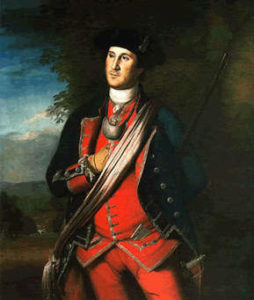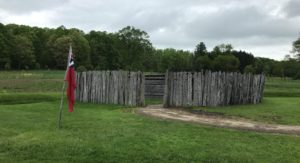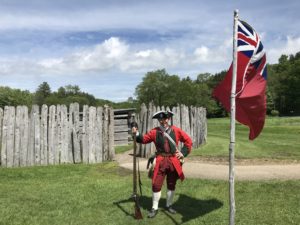
After the skirmish at Jumonville Glenn (May 28, 1754), George Washington beat a hasty retreat with his men back to the Great Meadows. Because he was concerned about a retaliatory attack by the French, he ordered his men to construct a small fort. He called it a “fort of necessity.” Shortly after they started the fort, the rest of the company finally caught up to him. When they did, Washington found out that Colonel Joshua Fry, leader of the expedition, had died after a fall from his horse. George Washington, just 22 years old, was now in charge of an army.
The fort of necessity built in the Great Meadows was just a rudimentary stockade for supplies. It was only 52 feet in diameter. The fort was never meant to protect a regiment from an attack, being round and much too small to house many men. A small cabin in the middle held gunpowder and other supplies. Earthwork entrenchments surrounded the small fort. The men completed Fort Necessity on June 3, 1754.

Soon after the completion of Fort Necessity, Captain James Mackay arrived with the South Carolina Independent Company. Captain Mackay thought he should be in charge of all the men because he was a captain in the British army. George Washington thought he should be in charge because he was a colonel. But Captain Mackay looked down on Washington’s Virginia regiment as colonial militia. In order to avoid continued conflict with Mackay, Washington took most of his men into the woods to continue building the military road they had started before Jumonville Glenn.

When Washington learned that a large force of French and Indians was advancing from Fort Duquesne, he returned with his men to Fort Necessity. On July 2 all the men gathered at the fort, about 400 British and Virginia troops, and prepared for the coming battle.
To find out what happens next, join me next week for Fort Necessity History Lesson 4.
